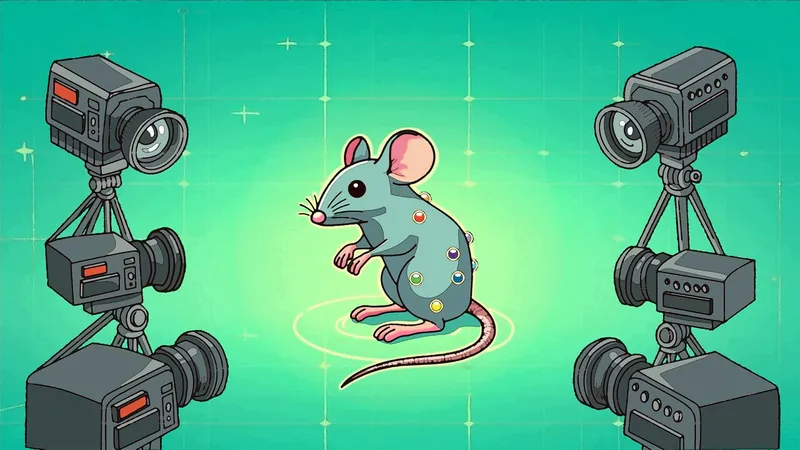
Revolutionizing Mouse Research: How Hollywood's Motion Capture is Unleashing New Frontiers in Neurological Studies
2025-06-30
Author: Wei
In the quest for groundbreaking treatments for neurological disorders like Parkinson's disease, scientists are now harnessing cinematic technology to refine their research. Mouse models play a crucial role in drug development, especially for conditions that impact movement. Recognizing the need for precision in measuring even the tiniest movements, researchers at the Okinawa Institute of Science and Technology (OIST) have turned to the Hollywood movie industry for inspiration.
A Groundbreaking Motion Capture Method
In a recent publication in eNeuro, the innovative team at OIST's Neuronal Rhythms in Movement Unit unveiled a novel motion capture technique specifically designed for mice. This marker-based approach allows for high-resolution tracking of mouse movements, steering clear of the cumbersome data processing typically associated with AI or machine learning. The result? Remarkably detailed insights into complex behaviors like running and climbing.
Dr. Bogna Ignatowska-Jankowska, the first author of the study, emphasizes the vast potential of this technology: "Marker-based motion capture is largely used in entertainment for video games and blockbuster films. With its precision in 3D tracking, it possesses the capability to revolutionize neuroscience research."
Overcoming Challenges in Mouse Motion Capture
Historically, attempts to capture mice movements have fallen flat. Factors such as their small size, curious nature (they tend to nibble on anything nearby), and behavioral shifts caused by attached equipment have thwarted previous efforts. However, this new methodology cleverly sidesteps those hurdles.
The team devised a setup featuring multiple cameras in three open environments—a flat surface, a treadmill, and a climbing wheel. Using reflective markers made of stainless steel, placed at strategic points on the mice, they ensured comprehensive tracking of movement.
Creating a Stress-Free Moving Environment
To capture natural behaviors without interference, the researchers intentionally designed an environment without walls, allowing for uninterrupted camera visibility. They focused on acclimating the mice to the markers, facilitating a relaxed and free-roaming atmosphere for the animals.
As Professor Yoe Uusisaari, the unit head, stated, "We emphasized humane animal handling over traditional reward or punishment systems. Letting the mice roam freely allowed us to observe their natural movements and minimized stress, resulting in richer data collection."
Uncovering the Details of Natural Movement
The 3D motion capture enabled researchers to document both subtle tremors and vigorous actions. As the mice ran, climbed, and explored, the team meticulously measured limb speed and step height, piecing together a comprehensive representation of mouse movement. The technique’s sensitivity helped to capture even the most elusive changes that would ordinarily escape the naked eye.
Paving the Way for Deeper Neuroscientific Insights
Looking ahead, the researchers are eager to leverage this groundbreaking motion capture data to deepen their understanding of mouse behavior. Professor Uusisaari noted, "Our data has substantially less noise and error compared to conventional methods. By applying advanced mathematical and computational models to such high-quality data, we can probe into the neuroscientific and physiological mechanics behind how and why mice move as they do."
Examining Brain Mechanisms and Behavioral Links
Different brain mechanisms govern various behaviors, whether they are instinctive, like running, or exploratory, like navigating an open area. By capturing comprehensive 3D data of mice engaged in distinct activities, researchers aspire to create more accurate models outlining how specific brain regions are impacted by medications or diseases. This innovative approach promises to unlock critical insights that could pave the way for enhanced treatments in neurological health.



 Brasil (PT)
Brasil (PT)
 Canada (EN)
Canada (EN)
 Chile (ES)
Chile (ES)
 Česko (CS)
Česko (CS)
 대한민국 (KO)
대한민국 (KO)
 España (ES)
España (ES)
 France (FR)
France (FR)
 Hong Kong (EN)
Hong Kong (EN)
 Italia (IT)
Italia (IT)
 日本 (JA)
日本 (JA)
 Magyarország (HU)
Magyarország (HU)
 Norge (NO)
Norge (NO)
 Polska (PL)
Polska (PL)
 Schweiz (DE)
Schweiz (DE)
 Singapore (EN)
Singapore (EN)
 Sverige (SV)
Sverige (SV)
 Suomi (FI)
Suomi (FI)
 Türkiye (TR)
Türkiye (TR)
 الإمارات العربية المتحدة (AR)
الإمارات العربية المتحدة (AR)